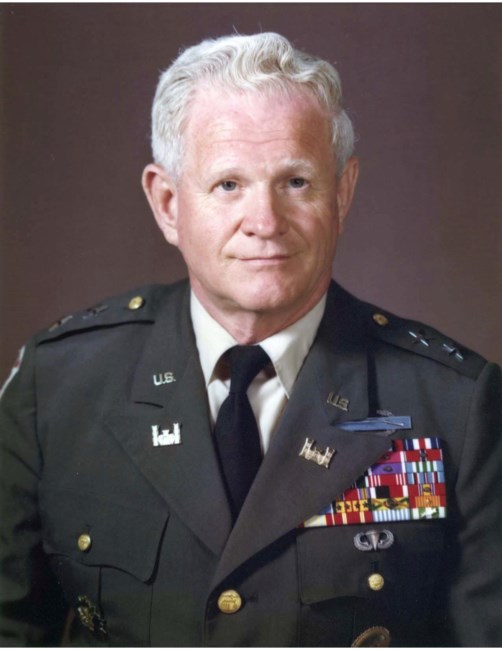
OBITUARY
James Allen Johnson
June 2, 1924 – July 20, 2016

Major General James Allen Johnson (US Regular Army, Retired) died on July 20, 2016, at Fort Belvoir, Virginia. Born in 1924 in Stoughton, Wisconsin, to Norwegian immigrants Martinus H. and (Aminda) Sofie K. Johnson, Jim was the youngest of 11 children. Following his graduation in 1942 as class president from Stoughton High School, he attended the University of Wisconsin for one semester before he was drafted as a private into the United States Army.
In 1944, he entered the U.S. Military Academy at West Point, New York. Graduating in 1947, he was commissioned as a 2nd Lieutenant in the Army Corps of Engineers. During assignment to Hawaii in 1949, he married Kathleen Clare Smith, of Owatonna, Minnesota. Mere months after their wedding, he was redeployed to Korea, where he served as an Engineer Platoon Leader and Infantry Company Commander with the 5th Regimental Combat Team. He experienced tough fighting, taking him north to the Yalu River, then south to the Pusan perimeter, and finally back north again to the infamous 38th parallel. Twice wounded during that deployment, he received a Purple Heart and Purple Heart with oak leaf cluster. He was also awarded the Silver Star, on January 12, 1951, for his “conspicuous courage, grim determination and selfless devotion to duty” in defending against and ultimately routing a large group of enemy troops that had attacked his platoon near Kogan ni, Korea.
Back in the United States, Jim returned to West Point to serve as a tactical officer and instructor from 1953 to 1955. He received his master’s degree in industrial engineering from Stanford University in 1957. He graduated in 1961 from the Army Command and General Staff College, and in 1966 from the Industrial College of the Armed Forces.
General Johnson was twice deployed to Vietnam, from 1964 to 1965 and 1971 to 1972. In his second tour, he served as Commanding General of the U.S. Army Engineer Command and Director of Construction for the Military Assistance Command, Vietnam, and was responsible for all construction resources for U.S. Forces in that country.
Early in his career, he had served as a Company Commander at Fort Belvoir. In 1974, he returned as Assistant Commandant of the Army Engineer School and Deputy Commanding General. In 1975 he was promoted to Commanding General of the Army Engineer Center and Commandant of the Army Engineer School.
In August 1977, he was appointed North Atlantic Division Engineer for the U.S. Army Corps of Engineers. Based in New York City, General Johnson had authority over the Corps’ civil works activities in the District of Columbia and all or part of eleven Mid-Atlantic states, from New York and Vermont to the James River Basin in Virginia, and military construction for DC and fifteen Mid-Atlantic and Northeastern states. While serving in that position, General Johnson was tasked with initiating the construction of a $1.04 billion project to place two airbases in the Negev Desert for the State of Israel, which was a critical commitment by the United States for the peace agreement between Israel and Egypt under the Camp David Accord. With the required construction to be completed in a three-year time frame and a two-year operational capability, General Johnson’s keen manage¬ment and organizational skills were assured a timely initiation of the effort. Through his efforts, the contractors were selected and construction began within six months of the assignment of the project.
In June 1979, General Johnson was appointed Deputy Chief of Engineers, and served concurrently as Chairman of the Board of Engineers for Rivers and Harbors and the Research and Development Review Board for the U.S. Army Corps of Engineers. He retired from that position in August 1980.
General Johnson’s military awards include two Distinguished Service Medals, Purple Heart with Oak Leaf Cluster, Silver Star, Legion of Merit with Oak Leaf Cluster, Bronze Star with Oak Leaf Cluster, Air Medal, Joint Service Commendation Medal, Army Commendation Medal, Combat Infantry Badge, and Parachutist Badge.
In 1980, Jim retired from the Army and settled in Fairfax Station, VA, serving as a businessman and engineering consultant.
Jim is survived by his loving wife, Kathleen Johnson; older brother, Martin Johnson (retired); four children, daughter Pamela Meister and husband, Stephen of Arlington, Massachusetts; son James Allen Johnson, Jr. and partner, Frank Spencer of Alexandria, Virginia; son Mark Thomas Johnson and wife, Moyo of Fairfax Station, Virginia; and son Stephen Victor Johnsen of Springfield, Virginia; and four grandchildren – Alissa-Marie; Sean Martin and wife, Kyara; Leina-Mei; and Marika-Kei. Jim is also survived by many loving nieces and nephews and a host of friends.
Jim possessed a keen intelligence and great sense of humor. He loved his family, his Norwegian heritage, the Army, West Point, and Fort Belvoir.
Arrangements under the direction of Demaine Funeral Home, Springfield, VA.
Show your support
Add a Memory
Share Obituary
Get Reminders
Services
SHARE OBITUARYSHARE
- GET REMINDERS
v.1.18.0